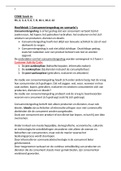Samenvatting
Summary All tasks of Body and Behaviour PSY 1023
- Instelling
- Maastricht University (UM)
ALL TASKS OF IPN & PSY 1023 Body and Behaviour English: Extensive elaboration of all tasks of the BB block. Co-written with what the tutor said (usually in red). An 8 for this exam. Dutch: Uitgebreide uitwerking van alle taken van het blok BB. Meegeschreven met wat de tutor zei (meestal in rood). E...
[Meer zien]













